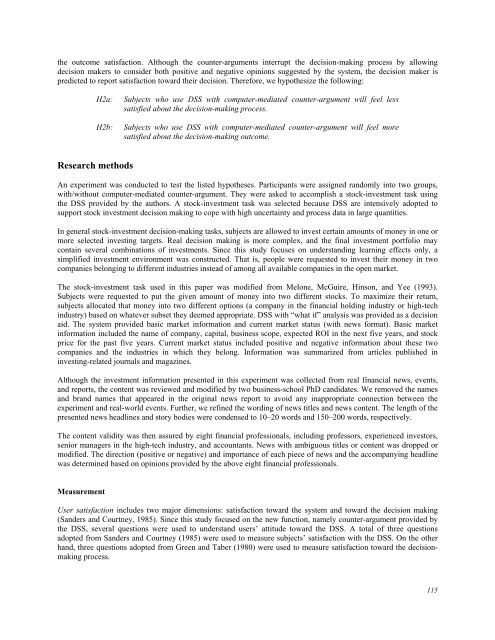October 2011 Volume 14 Number 4 - Educational Technology ...
October 2011 Volume 14 Number 4 - Educational Technology ...
October 2011 Volume 14 Number 4 - Educational Technology ...
Create successful ePaper yourself
Turn your PDF publications into a flip-book with our unique Google optimized e-Paper software.
the outcome satisfaction. Although the counter-arguments interrupt the decision-making process by allowing<br />
decision makers to consider both positive and negative opinions suggested by the system, the decision maker is<br />
predicted to report satisfaction toward their decision. Therefore, we hypothesize the following:<br />
Research methods<br />
H2a: Subjects who use DSS with computer-mediated counter-argument will feel less<br />
satisfied about the decision-making process.<br />
H2b: Subjects who use DSS with computer-mediated counter-argument will feel more<br />
satisfied about the decision-making outcome.<br />
An experiment was conducted to test the listed hypotheses. Participants were assigned randomly into two groups,<br />
with/without computer-mediated counter-argument. They were asked to accomplish a stock-investment task using<br />
the DSS provided by the authors. A stock-investment task was selected because DSS are intensively adopted to<br />
support stock investment decision making to cope with high uncertainty and process data in large quantities.<br />
In general stock-investment decision-making tasks, subjects are allowed to invest certain amounts of money in one or<br />
more selected investing targets. Real decision making is more complex, and the final investment portfolio may<br />
contain several combinations of investments. Since this study focuses on understanding learning effects only, a<br />
simplified investment environment was constructed. That is, people were requested to invest their money in two<br />
companies belonging to different industries instead of among all available companies in the open market.<br />
The stock-investment task used in this paper was modified from Melone, McGuire, Hinson, and Yee (1993).<br />
Subjects were requested to put the given amount of money into two different stocks. To maximize their return,<br />
subjects allocated that money into two different options (a company in the financial holding industry or high-tech<br />
industry) based on whatever subset they deemed appropriate. DSS with “what if” analysis was provided as a decision<br />
aid. The system provided basic market information and current market status (with news format). Basic market<br />
information included the name of company, capital, business scope, expected ROI in the next five years, and stock<br />
price for the past five years. Current market status included positive and negative information about these two<br />
companies and the industries in which they belong. Information was summarized from articles published in<br />
investing-related journals and magazines.<br />
Although the investment information presented in this experiment was collected from real financial news, events,<br />
and reports, the content was reviewed and modified by two business-school PhD candidates. We removed the names<br />
and brand names that appeared in the original news report to avoid any inappropriate connection between the<br />
experiment and real-world events. Further, we refined the wording of news titles and news content. The length of the<br />
presented news headlines and story bodies were condensed to 10–20 words and 150–200 words, respectively.<br />
The content validity was then assured by eight financial professionals, including professors, experienced investors,<br />
senior managers in the high-tech industry, and accountants. News with ambiguous titles or content was dropped or<br />
modified. The direction (positive or negative) and importance of each piece of news and the accompanying headline<br />
was determined based on opinions provided by the above eight financial professionals.<br />
Measurement<br />
User satisfaction includes two major dimensions: satisfaction toward the system and toward the decision making<br />
(Sanders and Courtney, 1985). Since this study focused on the new function, namely counter-argument provided by<br />
the DSS, several questions were used to understand users’ attitude toward the DSS. A total of three questions<br />
adopted from Sanders and Courtney (1985) were used to measure subjects’ satisfaction with the DSS. On the other<br />
hand, three questions adopted from Green and Taber (1980) were used to measure satisfaction toward the decisionmaking<br />
process.<br />
115

















